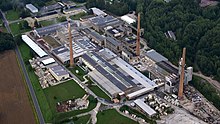Wetro
|
Wetro
Wětrow Community Puschwitz
Coordinates: 51 ° 15 ′ 3 ″ N , 14 ° 18 ′ 30 ″ E
|
|
|---|---|
| Height : | 136 m above sea level NN |
| Residents : | 278 (Dec. 31, 2016) |
| Incorporation : | April 1, 1936 |
| Postal code : | 02699 |
| Area code : | 035933 |
Wetro , Upper Sorbian , is a place in the center of the Bautzen district in East Saxony and has belonged to the Puschwitz community since 1936 . The place is part of the official Sorbian settlement area in Upper Lusatia .
geography
The place is located about 13 kilometers northwest of the large district town of Bautzen between the places Puschwitz and Neschwitz and consists of the old village Wetro and the settlement Wetro, which was created in the 20th century. The two districts are separated by a wooded hill. The old square village Wetro is located on the eastern slope of the hill between 180 and 195 meters above sea level. NN. Directly to the south is the Wetro landfill. At over 210 meters, it represents the highest elevation in the area. The Wetro settlement, on the other hand, is located on a relatively flat area at 173 m north of the old village. It consists of nine (formerly eleven) apartment blocks, the culture house and the factories of the refractory plants.
The neighboring towns are Neschwitz in the northeast, Uebigau in the east and Puschwitz in the west.
history
The village Wetro was mentioned for the first time in 1374 in a document from the St. Marienstern monastery as Wytrow and was part of its property until the 19th century. The name comes from the Sorbian word wětr for "wind" and refers to the location on the windy eastern slope.
Until April 1, 1936, Wetro was an independent rural community, which was then incorporated into Puschwitz.
In 1940 a bottle with a total of 1433 coins from the 12th century was found in a sand pit near Wetro.
Industrial history
As early as the 18th century there were several clay and loam pits between Wetro, Puschwitz and Guhra. From 1817, lignite was also mined in shafts. While the Puschwitz lignite works developed from coal mining , the refractory works in Wetro emerged from the clay pits. Soon the coal was only a by-product of clay mining. In 1898 the chamotte factory was founded.
In the 1950s, as part of the industrial expansion after the Second World War , the Wetro refractory works , the housing estate for 89 families and a new cultural center were built on the site of the historic Wetro brickworks . Between 1959 and 1963, the fireclay factory was expanded to become one of the largest in the GDR. The VEB Feuerfestwerke had 2100 employees in the meantime, of which about 700 were in Wetro itself. In 1968 the housing estate was expanded.
population
Up until the 20th century, Wetro was a small Sorbian farming village with fewer than 100 inhabitants. For his statistics on the Sorbian population in Upper Lusatia, Arnošt Muka determined a population of 93 inhabitants in the 1880s; 91 of them were Sorbs (98%) and two were Germans.
The population structure and with it the linguistic conditions changed with the growth of the Wetroer industrial companies, especially after the Second World War. By 1965, Wetro had quintupled its population and became by far the largest district of the municipality of Puschwitz with around 45% of the total population.
After the collapse of the GDR, numerous jobs were also cut at the Wetro refractory plant. This made the settlement one of the fastest shrinking places in the district. The emigration brought enormous problems for the municipality of Puschwitz, which today is one of the most heavily indebted in the region. Wetro now has just under 300 residents. In 2009, the demolition of some vacant apartment blocks began.
religion
The majority of the devout residents are traditionally Evangelical Lutheran. The place has been parish to Neschwitz since the 16th century.
Economy and Infrastructure
Despite the layoffs in the 1990s, the Wetro refractory works, their open-cast mine and the connected industrial waste dump are by far the most important economic factor for Wetro, the Puschwitz community and the surrounding area. Today you belong to the Preiss-Daimler group of companies . Another industrial employer is the Mammut-Wetro melting pot . The Wetro landfill is the only class III (hazardous waste) in Saxony.
The No Name (formerly FUN Center ), a regionally known discotheque, is now housed in the former Wetroer Kulturhaus .
Wetro is on the highway 98 (Crostwitz-Neschwitz) to the nearby federal highway 96 and the highway junction Bautzen-West ( A 4 tailed). There is a well-developed connection to the S 100 and the Salzenforst junction for the landfill .
literature
- Western Upper Lusatia between Kamenz and Königswartha (= values of our homeland . Volume 51). 1st edition. Akademie Verlag, Berlin 1990, ISBN 3-05-000708-7 , p. 154 f.
Individual evidence
- ↑ Ernst Tschernik: The development of the Sorbian population . Akademie-Verlag, Berlin 1954, p. 54 .
Web links
- Wetro in the Digital Historical Directory of Saxony




